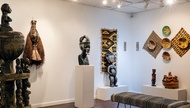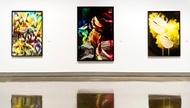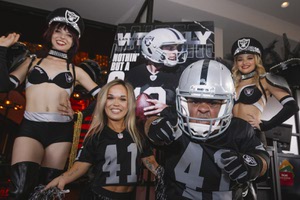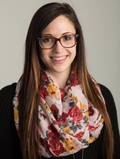The fine arts space soon to be known as the Barrick Museum of Art began life in 1967, even before it was part of the UNLV campus proper. In 1975, it became the UNLV Museum of Natural History and moved into the school’s old gym space (hence the presence of cartoon-wolf mascot Beauregard on the gallery floor today). Its first contemporary art exhibit took place in 1986, three years before the Marjorie Barrick part of the name got added.
In the decades since, the museum has continued to evolve, and in celebration of its 50th birthday, it has planned some innovative changes for 2017, kicked off by this month’s rebranding: the addition of “of Art” to the name and the development of a new logo. Interim director Alisha Kerlin, 35, filled us in.
What’s the purpose behind the latest name change? We have Mesoamerican art objects in the Braunstein gallery, and we house one of the most famous and inspiring donations of contemporary art in recent American history—the Nevada portion of the Dorothy and Herbert Vogel 50x50 Collection. [Given] the fact that we have those two massive collections and that we’re growing our own collection of contemporary artists with ties to Southern Nevada, it’s natural to have “of Art” by the name.
[The name change] really came through the support of the new dean [of the Fine Arts College], Nancy J. Uscher. She’s an absolutely wonderful visionary.
As a UNLV graduate, I feel like more students should be visiting the Barrick. How are you working to attract more? For a lot of students, if they don’t have a class [at the museum] and they’re not feeling adventurous, they may not even walk through the doors until their final year. But we’re changing this.
English 101 classes have been visiting for the past few years. They come through and look at art and describe what they see through essays, discussion and dialogue. And when you ask them to describe what they see, sometimes you have to wait through the silence. They may not know how to describe an abstract piece of art and be able to say that it’s valid. After they leave, although some may not be converted, they at least know that an artist has intent and that they’re bringing their own choices to the work.
We’ve also been talking to the CSUN Preschool on campus. Toddlers enjoy Edward Burtynsky, for example, and they’ve been coming to a lot of our programming. So that’s a new generation of art lovers.
How can you further extend the experience to the community? I want to bring in Clark County School District students for tours. I want to have a school bus out there every day, so that when they finally go to college and we ask them, “Have you ever been to an art museum?” more than half of them raise their hand.
When someone who’s not used to looking at art is in a tour here at the Barrick and you see that light bulb go off, and they realize that art is something more than just what it looks like, that’s significant. It doesn’t happen every tour, but it does happen. We are providing first-time museum experiences to people, and if they leave and have had a positive experience, that’s really inspiring.
What do you hope visitors take away from their Barrick experience? It’s really important to see artwork in person. I remember the first time I saw an artwork in person that I had only seen in a flat magazine. It was a crazy experience. And we get to see a version of that here almost every day when we’re busy—we get to see people have those reactions.
Our tours are not about telling people what to think or what the art is about. We ask questions, like, “What do you see?’ They’re very interactive, question-led tours. If I get up there and tell them why an art piece is important, that’s really not that interesting. If they can come to the conclusion that something is important to them, or even not, at least they’re engaging. It’s really inspiring to see people have that a-ha moment.
How many pieces does the Barrick have in its collection? We have over 10,000 objects here, all art-related. This place is very inclusive; it doesn’t try to alienate anyone in what we show, but we do show challenging work. The whole point is to normalize art, that it’s a part of your everyday life.
What inspired the logo change? I wanted to create new posters, postcards and print material that would reflect our current state as an edgy and educational art museum. We came to the conclusion that the ceiling tiles [in the main gallery] really mark the space. Those that may not know what the museum looks like might think of the logo as a labyrinth or maze or a contemporary art painting.
And a UNLV student designed it, right? Yes. Luis Carillo is the vice president of the UNLV Student Association of Graphic Artists, and a Las Vegas chapter member of the American Institute of Graphic Arts. He has five years of professional experience.
You’ll unveil the changes when the new semester begins this month? Yes, we have a huge opening celebration coming up. For the first time in a while, we’re opening three shows at once: our Mexican and contemporary art mask show [Masking] curated by Karen Roop [assistant director of English composition]; Salvador Dali prints and books [Abandon All Hope, Ye Who Enter Here] in our Teaching Gallery, curated by Lee Cannarozzo, our history intern; and Process, an amazing, multimedia exhibition of work that focuses on the artists’ studio and their process versus the end product.
Besides those three exhibitions, you’ll also have a Fifty Years display in the lobby. Tell me about that. That was organized by a history graduate here at UNLV, Allen Linnabary, who is also Barrick staff. We’ve gone through our archive and were looking at all these wonderful newspaper clippings and old photos. We picked a few and put them on display. The cutest piece is a guestbook from 1977 that the previous director, Aurore Giguet, signed as a young child. She signed her name and her father’s name, who was the director before her.
The Barrick will also host some screenings by Josh Azzarella. We’ll be showing it at the [January 27?] opening, but it’s a semester-long screening. He’s the kind of artist who will take a historic event, like the shooting of JFK, and deconstruct the footage, and deconstruct it over and over again and stretch it out. So, in watching, it, you really understand the importance of an image. If you can’t make it to the screening times, make an appointment with us, and we’ll show it.
What other programming do you have scheduled for 2017? We have an amazing year coming up. Kara Joslyn, an artist featured in Process, is coming on February 16 to do a fine art, paper-building, all-ages workshop to make large-scale sculptures. John Bauer [also featured in Process] will talk about Photoshop, mediated experience and painting, and you can see his works. He’ll also give a lecture as part of the University Forum [Lecture Series], which should be huge. On April 10, [author] Sharon Louden will do a panel all about artists and their extended practice—artists as cultural producers.
What else does the Barrick have planned for 2017? We’re starting a 50 Gifts for 50 Years campaign, looking for monetary gifts and gifts of artwork for the collection. We’re creating catalogs, which we haven’t done in a while. I’m looking to have a small museum shop. I also want to invite artists to lead Visitor Made series workshops, so that people can have a chance to speak with the makers of what’s in our exhibition hall.
How do you think the Barrick figures into the Valley’s overall art scene? You can always rely that we’re going to be open—we’re one of the few places that has 9-5 hours, and we’re open six days a week—and that we’ll have engaging programming. And one of the most important things is that we’re free.
Our core collection of contemporary artists with ties to Southern Nevada is an asset to not only UNLV and educational art scholars and historians, but to Las Vegans from all walks of life who are searching for a deepened sense of pride in our city. If we celebrate what we have, and we’re proud of it and support it, then this dialogue, this broken record of us not being a cultural city, might start to fade a little bit.
Barrick Museum of Art Monday-Friday, 9 a.m.-5 p.m. (Thursday until 8 p.m.); Saturday, noon-5 p.m.; suggested donation $2-$5. UNLV, 702-895-3381.








